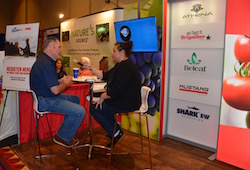![]() AgTech Accelerator is a unique startup accelerator vehicle with a goal of developing emerging agricultural technology companies. Today they’ve announced they’ll be able to further their goal with the addition of $8.5 million in financing. This funding brings the company’s total capital to $20 million, thanks to Elanco, a leader in animal health and food production. Other investors include Bayer, Syngenta Ventures, Alexandria Venture Investments, ARCH Venture Partners, Flagship Ventures, Harris & Harris Group, Inc., Hatteras Venture Partners, Mountain Group Capital and Pappas Capital.
AgTech Accelerator is a unique startup accelerator vehicle with a goal of developing emerging agricultural technology companies. Today they’ve announced they’ll be able to further their goal with the addition of $8.5 million in financing. This funding brings the company’s total capital to $20 million, thanks to Elanco, a leader in animal health and food production. Other investors include Bayer, Syngenta Ventures, Alexandria Venture Investments, ARCH Venture Partners, Flagship Ventures, Harris & Harris Group, Inc., Hatteras Venture Partners, Mountain Group Capital and Pappas Capital.
Elanco is dedicated to understanding how healthy animals make lives better. That includes safe, affordable food for an increasing populations, as well as pet health as they become more and more important to families.
“Today, more than 20 percent of livestock productivity is lost to death and disease globally. While we’ve made important advances in animal health, we still have significant unmet health needs that must be addressed if we’re to tackle today’s challenges – from improving global food security to combatting antimicrobial resistance,” said Jeff Simmons, president of Elanco and senior vice president of Eli Lilly and Company. “We look forward to joining AgTech Accelerator in working collaboratively across the agriculture technology continuum to bring new ideas to life. We believe this effort can make a difference in shaping a future with sustainable health outcomes for people, animals and the planet.”
Elanco represents an important addition to AgTech Accelerator’s strategic investor syndicate, which consists of the world’s foremost leaders across the agricultural technology continuum. Through its efficient operating platform and deeply experienced team, AgTech Accelerator provides all the necessary resources for the next generation of innovative startups to successfully develop the most promising agriculture-focused technologies addressing the world’s growing population, related food and water shortages and supply chain constraints.
“This is a really exciting time across all sectors of agriculture given the active consolidation of the large, traditional players,” said Kristina Burow, managing director at ARCH Venture Partners and member of the AgTech Accelerator board. “Talent pools are being unlocked and market forces are triggering the opportunity for unprecedented innovation and collaboration. The AgTech Accelerator plays a significant role in helping us take advantage of these new and really intriguing investment opportunities.”
AgTech Accelerator believes they are in a position to help develop companies that will benefit agribusiness innovation. They use the experience from their investors, as well as a scientific advisory board, dedicated management team and leading academic researchers to provide a broad, deep experience.








